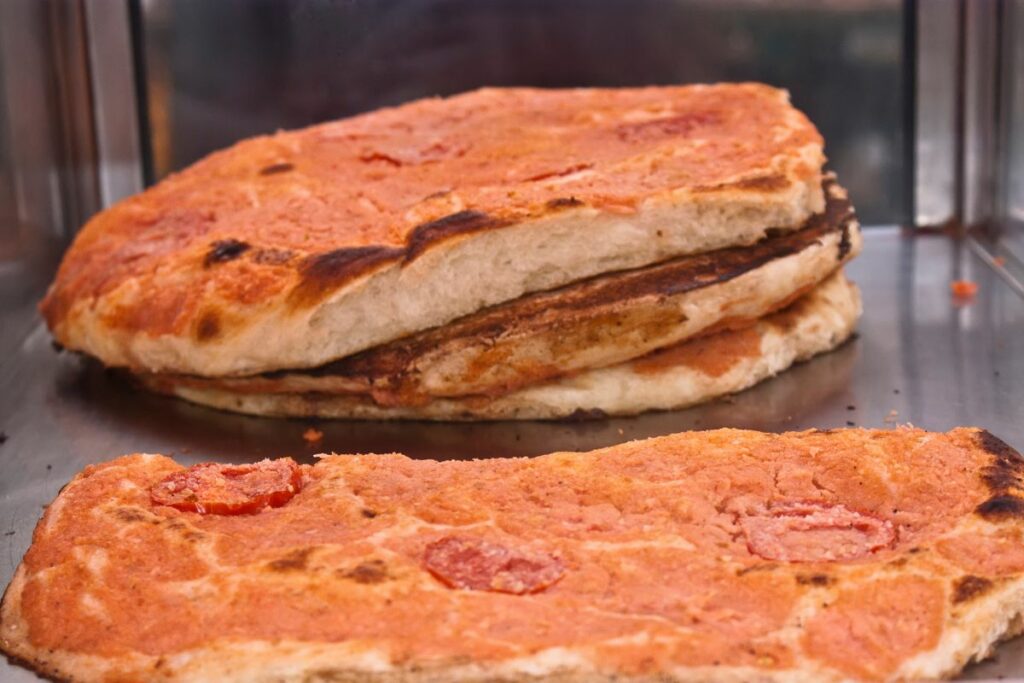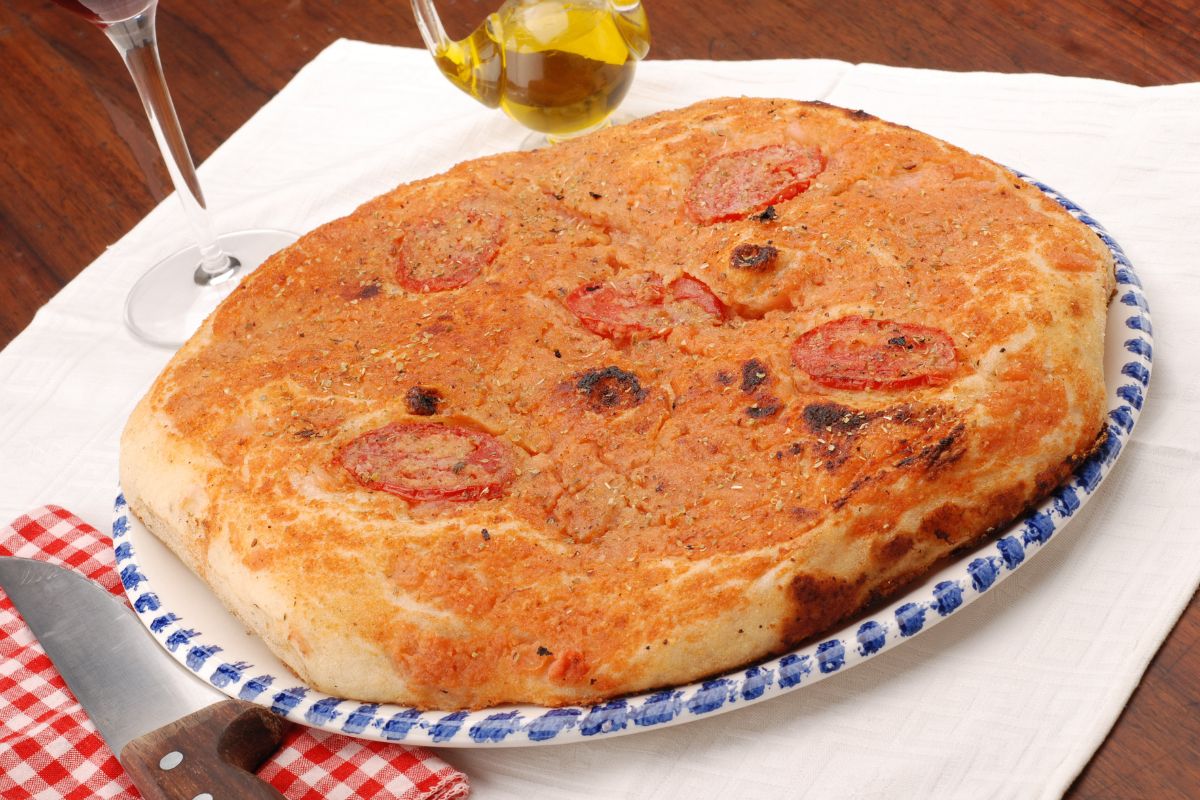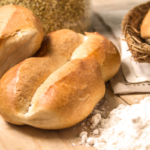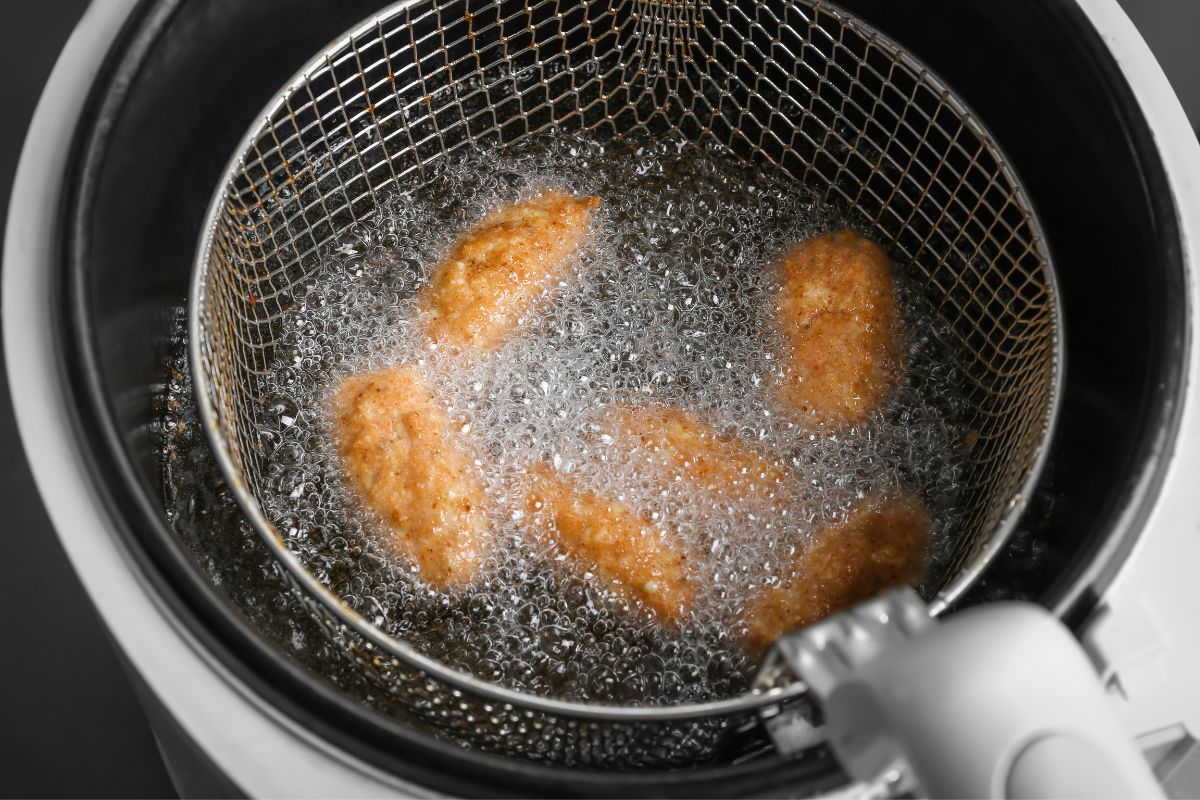If you’ve never had a Sicilian pizza then you are seriously missing out. The pizza that most people know as thick, deep and always square is what has come to be known as Sicilian pizza.
But what did the original Sicilian pizza look and taste like?

We have found what we believe to be the best Sicilian pizza recipe that gets as close as possible to the original recipe from Palermo.
We’ll dive into what makes the Sicilian different from a Neapolitan pizza or a deep dish pizza.
Understanding the history of this dish helps us to understand how it came to occupy such an affectionate place in the hearts and homes of many Americans.
We’ll discover more than one variety of Sicilian pizza and then finally, it’s down to business to make that delicious dish.
What Makes Sicilian Pizza Different?
Sicilian pizza comes from the Palermo region of the island and is called ‘sfincione’ there.
This translates to ‘thick sponge’ which gives some indication of the texture and consistency of this pizza crust.
The Sicilian pizza is closer to a focaccia than other types of pizza and offers a thicker crust similar to the amount in a ‘pan style’ pizza.
The difference between them is that there is a distinct border on the deep pan whereas the Sicilian has the sauce and toppings going right to the edge of the dough.
When the Sicilian migrated to the United States it took on the square or rectangular shape now associated with it as these were the only pans that could hold the spongy crust.
In Sicily, you will still find round pizzas that follow the traditional recipes. Although they typically have more cheese and sauce than some other styles.
In the US a Sicilian pizza must have a crust that is at least one inch thick in order to be entitled to the name.
History Of Sicilian Pizza
Pizza was popular in Sicily by the middle of the 19th century, and it is thought likely that they evolved from the focaccia bread.
This is a yeast bread that is baked in a flat sheet pan and often topped with herbs and vegetables.
Sicilian pizza was brought to the US by Sicilian immigrants and was adapted to suit the available ingredients and cookware in this country.
As we have mentioned before, the use of rectangular and square pans is an American twist on the Sicilian pizza.
Additionally, the use of mozzarella on the pizzas was not a Sicilian tradition but one that was initiated in the United States. This is probably due to the availability of cheap mozzarella in New York State from their dairy cow industry in the early 20th century.
Pretty soon the term ‘pizza’ came to mean any kind of bread crust topped with cheese and sauce.
After the Second World War soldiers returning from Italy were clamoring for the pizza they had eaten when stationed in that country.
As a result a culinary trend arose in New York City, Detroit and Boston. Detroit pizza is actually a descendant of Sicilian pizza.
Variations Of Sicilian Pizza

The evolution of Sicilian pizza from its Italian origin to the streets of the United States is only one story in its history.
Sicilian pizza has many variations even in Sicily. Different regions have different variations of this classic dish.
From Palermo in the north, Messina in the north east, Catania in the east and Syracuse in the south east all have their own style of this pizza.
Palermo
Palermo is where the Sicilian pizza originated. This variation is served in rectangular slices and has more of every ingredient than you would find in a Neapolitan pizza.
That means more dough, more sauce and more cheese.
The cheese used in this pizza is typically strongly flavored, and it has a rich sauce, often with garlic, herbs and onions. A traditional topping for Palermo style Sicilian pizza are anchovies.
Some pizza makers in Palermo will put the cheese on first and then spread on the sauce. This is to prevent the sauce from making the crust too soggy and to keep it nice and crisp.
Messina
Move eastward and in the Messina region the Sicilian pizza changes form and name. Here it is called piduni and is actually a type of calzone, or pizza roll. It is made with toma cheese, tomatoes, anchovies and endives.
Toma cheese is a traditional semi hard cheese from cow’s milk and the name means farmer’s cheese. It has a great melting texture and creates a tangy layer in the piduni.
Catania
Catania is a province on the east coast of Sicily, and again you’ll find a different kind of Sicilian pizza. This time it’s a case of city pizza versus surrounding region pizza.
But in both cases the pizza is made up of two dough layers with the ‘toppings’ in the middle. We think in this case they should be called ‘middlings’ but we digress.
In Catania city the pizza is called scacciata and has a layer of anchovies and toma cheese in the middle.
In the regions surrounding the city the pizza is more likely to have fillings of sausage, potato, broccoli and tomato sauce.
As if all this wasn’t confusing enough, two towns in the region have created yet another variation. This style is a calzone which is filled with cheese and anchovies and then fried.
Syracuse
In the southeastern province of Syracuse the Sicilian pizza is known as pizzòlu.
This version breaks with the tradition of being served in rectangular slices. This variation is round and cut into wedge shapes.
But that is where any resemblance to a Neapolitan pizza ends. This pizzòlu is formed from a standard base and has a layer of filling topped with a thin crust which is flavored with olive oil, Parmesan cheese and herbs.
This is a very filling pizza and one slice is typically enough for a meal for all but the largest appetites.
American
When the Sicilian pizza arrived on the shores of the United States it began yet another transformation.
It is always served as square or rectangular slices and the base is thick, more than an inch, but it is still light and crunchy.
This version of the Sicilian pizza is particularly popular in the north eastern states among Italian American demographics.
In some coastal areas of Massachusetts and New Hampshire it is known as beach pizza for its convenience as a picnic food.
A Brooklyn version of the Sicilian pizza places the mozzarella cheese on the top of the base with the tomato sauce spread over the cheese.
As it is more exposed to the heat the tomato sauce reduces down creating a more intense and rich flavor.
Creating Sicilian Pizza Dough
The most important element of a pizza is the crust, so you need to get the dough right in order to have a good crust.
Just like a good sandwich requires nice bread, the same is true of a pizza. Get the dough right, and you have the best basis for a great pizza.
What Goes In The Dough?
A basic square pizza dough starts with bread flour or all purpose flour, some yeast, salt, olive oil and a lot of water.
The dough should have a hydration level of 70% which means for every kilogram of flour you’ll need 700 grams of water.
This amount of water creates a lot of large bubbles in the dough, adding to its lightness and crispiness.
It’s important to use a scale when making pizza rather than using volume measurements which for flour can often be inaccurate.
Mixing In The Water
When mixing the water into the flour there are three possible methods. First you can use a food processor which will get the job done a lot faster and easier.
This rapid and intense beating means that the gluten network in the dough will form very rapidly. It is this gluten network that gives the dough its structure, so it is very important.
You can use a stand mixer, but this is not as effective as a food processor and the gluten formation will not be up to the same standard.
Of course, it’s perfectly possible to do without equipment altogether and use the no-knead method.
Simply mix the ingredients in a bowl and cover with plastic wrap. Leave at room temperature for 12–24 hours to give the gluten network time to form.
Stretch It Out
Whatever method you use to mix the ingredients together the next phase is fairly straightforward. Oil a rimmed baking sheet and place the dough on it. Cover it with plastic wrap and let it rest.
If you try to stretch out the dough straight away it will want to pull back as it is still extremely elastic.
You need to let it relax over the course of a couple of hours. This allows the gluten to slacken off naturally so that the dough will slowly fill out the baking sheet.
It’s good practice to lift each corner of the dough and the edges to allow any trapped air bubbles to escape from underneath. The aim is to have a crispy golden brown crust on the finished pizza.
When you have stretched the dough out on the baking sheet let it rise again for a second time to allow extra bubbles to form, making the texture even lighter and crisper. You don’t need to cover it over at this stage.
Making The Sauce
Although the crust is arguably the most important element of a Sicilian pizza a good sauce is vital to its overall success. Start off as you mean to go on, with some excellent flavors.
Lots of chopped garlic sautéed in olive oil with some flavorful dried oregano and a sprinkling of red pepper flakes should do it.
Once they are cooked add your canned tomatoes. Use the best quality you can and whole tomatoes are best, so you can dictate the texture of the sauce. You also want a good balance between acidity and natural sweetness.
Break up the whole tomatoes with a stiff bladed pastry blender, it works great, and you can use it directly in the pan.
Choosing Your Toppings

Now that the dough is nicely relaxed, and the sauce is ready to go, all you need to do is prepare your Sicilian pizza toppings. Aged mozzarella cheese, Pecorino Romano cheese and natural casing pepperoni.
Mozzarella Cheese
The mozzarella cheese used in this pizza is not the same as the balls of fresh mozzarella used in Neapolitan pizzas. This mozzarella is dry and comes in blocks.
You will slice it and place it on top of the base as it goes under the sauce. This is just like the Palermo Sicilian pizza where it originates from.
Natural Casing Pepperoni
The use of natural casing pepperoni allows the edges of the slices to crisp and curl up as they cook.
A pool of rendered pepperoni fat forms in the middle giving the pizza an incredible flavor. This only happens with natural casing pepperoni, however.
Pecorino Romano cheese
Imported Pecorino Romano is the best, and you’ll be glad you chose it. This cheese comes in solid blocks, but you can either use the food processor or a box grater to grate it yourself.
Recipe
This recipe will provide 6–8 servings of pizza.
Preparation time is 15 minutes.
Rising time for the dough is 2 hours.
Cooking time is 35 minutes.
Ingredients
Dough
- 17 ½ ounces bread flour
- 1 tablespoon salt
- 1 ½ teaspoons rapid rise yeast
- 2 ounces olive oil
- 11 ½ ounces room temperature water
Sauce
- 2 tablespoons extra virgin olive oil
- 9 medium garlic cloves
- 1 tablespoon dried oregano
- 2 tablespoons red pepper flakes
- 28 ounce can whole peeled tomatoes
- 1 teaspoon sugar
- Salt
Toppings
- 1 pound sliced deli style mozzarella cheese
- 12 ounces natural casing pepperoni
- 4 ounces Pecorino Romano cheese
Directions
- Combine the flour, yeast, salt, 20 grams olive oil and water in the bowl of a food processor fitted with the dough blade attachment. Process until the dough forms around the blade. Continue processing for another 30 seconds. For the no knead method combine the dry ingredients and whisk. Add 20 grams of olive oil and the water. Mix with your hands until combined and no dry flour remains. Cover the bowl with plastic wrap and leave to rise at room temperature for 12–24 hours.
- Pour the remaining olive oil into a 13 inch by 18 inch baking sheet and spread around the whole surface with your hands. Transfer the dough onto the baking sheet and coat in the oil. Spread the dough gently with your hands. Cover with plastic wrap and leave to rise for a couple of hours.
- Remove plastic wrap and push dough gently into the corners of the pan from the center. Lift the corners and stretch beyond the edges of the baking sheet. It will pull back and fill the pan. Leave to one side while you make the sauce.
- Heat the olive oil in a saucepan over medium heat. Add the garlic, red pepper flakes, and oregano and cook for around one minute or until softened. Add the tomatoes and break up into small pieces with a pastry blender. Stir in the sugar and simmer for 15 minutes.
- Preheat the oven to 550 °F and adjust the oven rack to the lowest position.
- Assemble the pizza by first placing the slices of mozzarella as if you were laying shingles. Make sure they are evenly spread over the surface. Spoon the tomato sauce on top and spread with the back of a spoon. Spread the slices of pepperoni evenly over the surface of the pizza. Then sprinkle with half the Pecorino Romano.
- Transfer the pizza to the oven and bake until the pepperoni is crisp and the bottom of the pizza is golden brown. You can check by lifting the corner with a spatula. If the bottom is taking longer you can tent the pizza with aluminum foil until the crust is crisp and golden.
- Take the pizza out of the oven and sprinkle the remaining Pecorino Romano cheese over the surface. Use a pizza cutter to cut it into slices and serve immediately.
Final Thoughts
We believe that this is the best Sicilian pizza recipe you will ever find. By using good quality ingredients and accurate measurements involving weight rather than volume you will end up with a piece of pizza heaven.
Using a food processor creates a strong gluten network while baking in an olive oil coated pan ensures a crisp, golden crust.
Layering the cheese underneath the sauce rather than on top stops the crust from getting soggy. And using natural casing pepperoni will curl and crisp as it bakes providing amazing texture contrasts and incredible flavors.
We really hope that you have enjoyed our guide to the best Sicilian pizza recipe and that you truly enjoy it.
- How To Reheat A Cheesesteak - November 5, 2023
- What Are Three Must Have Kitchen Knives? - September 22, 2023
- How To Protect Edges Of Pie Crust - June 15, 2023








